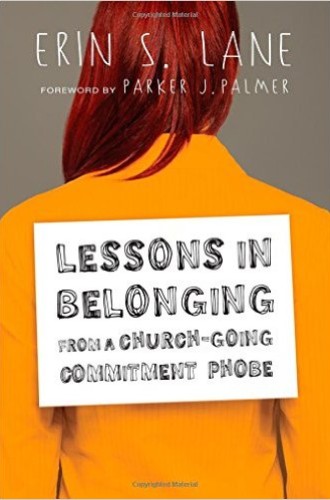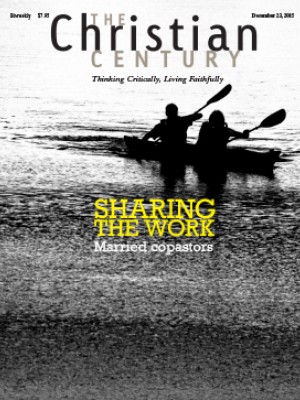Lessons in Belonging from a Church-Going Commitment Phobe, by Erin S. Lane
"I don’t think I’ve ever looked forward to going to church for the people.” You have to love a book that makes this declaration. Erin Lane tells a good story about her curious condition as an incurable introvert who nonetheless loves the church—and is married to a pastor to boot. Part church history, part spiritual memoir, part theological treatise on Christian community, Lessons in Belonging suggests how we might shed “illusions of how belonging should happen.”
Lane, who blogs at holyhellions.com, works at the Center for Courage and Renewal in Seattle. The center was founded by Parker Palmer, who wrote the book’s foreword. Lane grew up with a devoted Catholic dad and a determined seeker mom nicknamed Perk. Her dad modeled the importance of the sacraments, and Perk was “the binoculars” through which Lane “understood the shape of God.” They eventually divorced, and Lane reports that the “concept of a church home feels as fleeting to me as that of a stable family.” She has developed her understanding of commitment to her husband as she has wrestled to make a livable commitment to church. (Full disclosure: I taught Lane at Davidson College.)
Read our latest issue or browse back issues.
A millennial herself, Lane hopes to explain the reluctance of people of her generation to join a church. “Soft on responsibility. High on narcissism. . . . I say we’re scared out of our minds to be disappointed.” She defines the local church as a “vehicle of disillusionment.” Intimate community works when it pries us away from the illusions of difference, control, scarcity, and separateness. But millennials, who have “forgotten how” to belong, occupy a middle place between “the hyperreligious, who sometimes belong without questioning, and the nonreligious, who often question without belonging.” Lane asks readers to imagine what congregations can be for such a population.
Lane contends that church communities can be “where we get to be the people we really are.” Such a pronouncement might sound like a vapid pop psychology affirmation, but Lane gives her idea flesh by recounting how she came to take her first communion two years early after convincing her mother and the parish’s (female) head of religious education that her desire was sincere. In admitting her to Holy Communion, Lane writes, the parish “allowed me to witness my own strength and the strength of the church to endure me.” The congregation made room for her to be real—to be inconvenient, an upstart—in its midst.
Lane moves from meaty historical and theological exposition to funny-human confessions to withering critique without much warning. Readers from the digital generation to which she belongs—multitaskers with attention spans that turn on a dime—may respond well to this approach. Lane takes a risk here, though. Her nonmillennial readers may lose patience trying to keep track of the intertwining narrative threads. It is a little disorienting, these sudden shifts from personal narrative to theology to laugh-out-loud zinger. On the other hand, reading her book presents nonmillennials with an opportunity to practice millennial habits. And Lane’s disarming approach may gain the attention of her comillennials while smashing the self-assured nay-saying of the People in Charge—us middle-aged session and vestry members and the pastors, priests, and ministers who lead us.
My favorite chapter may be the one titled “Lesson Three: The Discipline of Showing Up,” perhaps because I too struggle with what so often feels like the burden of churchgoing. If being with “the people” is not sufficient inducement to attend worship regularly, then why go? What makes a community worth belonging to?
Lane’s answer: the sacraments of baptism and the Lord’s Supper help us to know God and each other. Together they keep the “feast of human words” that often characterizes Protestant worship “from overshadowing a taste of the Word incarnate.” Lane asks, “What is the point of worship if not to remember that God redeemed ordinary things like bread, wine and meandering sermons? What is the point if not to remember that God was redeeming me?” The strangeness of these sacramental practices brings us into fellowship with particular others whom we know by name. They also reinforce the strangeness of God and so prevent us from turning God into a too-familiar presence—especially a male-identified presence that “glorifies human masculinity” at the expense of other human ways of being. In Lane’s view, the church grows stronger and “our reality expands” when human and divine angularities speak aloud in embodied practice.
Lane wants to help millennials and those who love them to understand the real countercultural impulse of the church: the permission it gives—indeed, the command it speaks—to “start from the ground of our true being, a humanity fragile and flawed and dusty from the wrestling.” This message ought to be a refreshing one, especially for the hard-charging generation to which Lane belongs. But it also offers relief and rest and rescue to all churchgoers who long for more, regardless of how we label ourselves.
The recommendations Lane makes in her final lesson concretize the foregoing chapters. Churches, she insists, need to be spaces for one-on-one particularity, where people know each other as individuals, not as “universal and abstract” brothers and sisters in Christ. They need to walk the walk with regard to gifts and risk and strangers and love and honesty. Practicing what we claim about all of these things—that we have gifts worth offering and that God calls us to risk all by coming alongside strangers and sharing our most vulnerable truths with each other—would unmask the illusions we carry into church and the world: scarcity, separation, control, difference, alienation.
We make belonging happen, Lane writes, “not by cherry-picking people just like us” to be with, or “nitpicking people who don’t get us. Belonging happens when we choose to give ourselves away, saying”—with Jesus, who longs for us, too—“‘Take. Eat. If you’ll have me, I belong to you.’” Christians are “members of one another,” not members of an institution. If the church can echo millennials’ spiritual longing, then hope endures. If the church can give us practice in saying those simple words and living that challenging risk, then we might be on to something the world cannot resist.







